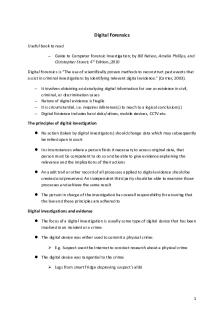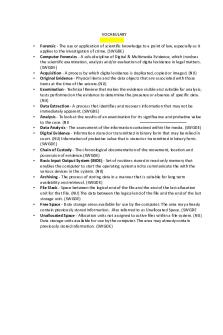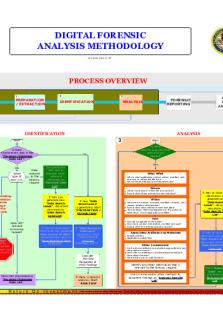Guide to Computer Forensics and Investigations: Processing Digital Evidence PDF

| Title | Guide to Computer Forensics and Investigations: Processing Digital Evidence |
|---|---|
| Author | Abigail Eason |
| Pages | 809 |
| File Size | 53.2 MB |
| File Type | |
| Total Downloads | 155 |
| Total Views | 480 |
Summary
Guide to Computer Forensics and Investigations: Processing Digital Evidence iStock.com/Vertigo3d Guide to Computer Forensics and Investigations: Processing Digital Evidence 6th Edition Bill Nelson Amelia Phillips Christopher Steuart Jonathan Lau SVP, GM Skills Lauren Murphy Product Director Kristin...
Description
Guide to Computer Forensics and Investigations: Processing Digital Evidence
iStock.com/Vertigo3d
Guide to Computer Forensics and Investigations: Processing Digital Evidence 6th Edition Bill Nelson Amelia Phillips Christopher Steuart Jonathan Lau SVP, GM Skills Lauren Murphy Product Director Kristin McNary Product Team Manager Amy Savino Product Manager Jake Toth Product Assistant Marah Bellegarde Executive Director, Content Design Leigh Hefferon Director, Learning Design Natalie Onderdonk Learning Designer Lisa M. Lord Development Editor Michele McTighe Sr. Marketing Director Cassie Cloutier Assoc. Marketing Manager Patty Stephan Director, Content Delivery Brooke Greenhouse Senior Content Manager Jim Vaughey Digital Delivery Lead Diana H. Graham Senior Designer SPi Global Production Service/Composition
Copyright Statement Guide to Computer Forensics and Investigations: Processing Digital Evidence COPYRIGHT © 2019, 2016 Cengage Learning, Inc. ALL RIGHTS RESERVED. No part of this work covered by the copyright herein may be reproduced or distributed in any form or by any means, except as permitted by U.S. copyright law, without the prior written permission of the copyright owner. For product information and technology assistance, contact us at Cengage Customer & Sales Support, 1-800-3549706 or support.cengage.com. For permission to use material from this text or product, submit all requests online at www.cengage.com/permissions. SOURCE FOR ILLUSTRATIONS: Copyright © Cengage. , Microsoft® is a registered trademark of the Microsoft Corporation. Library of Congress Control Number: 2018936389 ISBN: 978-1-337-56894-4 Cengage 20 Channel Center Street Boston MA 02210 USA Cengage is a leading provider of customized learning solutions with employees residing in nearly 40 different countries and sales in more than 125 countries around the world. Find your local representative at www.cengage.com. Cengage products are represented in Canada by Nelson Education, Ltd.
To learn more about Cengage platforms and services, visit www.cengage.com. To register or access your online learning solution or purchase materials for your course, visit www.cengagebrain.com. Notice to the Reader Publisher does not warrant or guarantee any of the products described herein or perform any independent analysis in connection with any of the product information contained herein. Publisher does not assume, and expressly disclaims, any obligation to obtain and include information other than that provided to it by the manufacturer. The reader is expressly warned to consider and adopt all safety precautions that might be indicated by the activities described herein and to avoid all potential hazards. By following the instructions contained herein, the reader willingly assumes all risks in connection with such instructions. The publisher makes no representations or warranties of any kind, including but not limited to, the warranties of fitness for particular purpose or merchantability, nor are any such representations implied with respect to the material set forth herein, and the publisher takes no responsibility with respect to such material. The publisher shall not be liable for any special, consequential, or exemplary damages resulting, in whole or part, from the readers’ use of, or reliance upon, this material.
Preface Guide to Computer Forensics and Investigations is now in its sixth edition. As digital technology and cyberspace have evolved from their early roots as basic communication platforms into the hyper-connected world we live in today, so has the demand for people who have the knowledge and skills to investigate legal and technical issues involving computers and digital technology. My sincere compliments to the authors and publishing staff who have made this textbook such a remarkable resource for thousands of students and practitioners worldwide. Computers, the Internet, and the world’s digital ecosystem are all instrumental in how we conduct our daily lives. When the founding fathers of the modern computing era were designing the digital infrastructure as we know it today, security and temporal accountability issues were not at the top of their list of things to do. The technological advancement of these systems over the past 10 years has changed the way we learn, socialize, and conduct business. Finding digital data that can be used as evidence to incriminate or exonerate a suspect accused in a legal or administrative proceeding is not an easy task. Cyberthreats have become pervasive in modern society. They range from simple computer viruses to complex ransomware and cyber extortion schemes. The ability to conduct sophisticated digital forensics investigations has become a requirement in both the government and commercial sectors. Currently, the organizations and agencies whose job it is to investigate both criminal and civil matters involving the use of rapidly developing digital technology often struggle to keep up with the everchanging digital landscape. Additionally, finding trained and qualified people to conduct these types of inquiries has been challenging.
Today, an entire industry has evolved for the purpose of investigating events occurring in cyberspace to include incidents involving international and corporate espionage, massive data breaches, and even cyberterrorism. The opportunities for employment in this field are expanding every day. Professionals in this exciting field of endeavor are now in high demand and are expected to have multiple skill sets in areas such as malware analysis, cloud computing, social media, and mobile device forensics. Guide to Computer Forensics and Investigations can now be found in both academic and professional environments as a reliable source of current technical information and practical exercises concerning investigations involving the latest digital technologies. It’s my belief that this book, combined with an enthusiastic and knowledgeable facilitator, makes for a fascinating course of instruction. As I have stated to many of my students in the past, it’s not just laptop computers and servers that harbor the binary code of ones and zeros, but an infinite array of digital devices. If one of these devices retains evidence of a crime, it’s up to newly trained and educated digital detectives to find the evidence in a forensically sound manner. This book will assist both students and practitioners in accomplishing this goal. Respectfully, John A. Sgromolo As a Senior Special Agent, John was one of the founding members of the NCIS Computer Crime Investigations Group. John left government service to run his own company, Digital Forensics, Inc., and has taught hundreds of law enforcement and corporate students nationwide in the art and science of digital forensics investigations. Currently, he serves as a
senior consultant for Verizon’s Global Security Services, where he helps manage the Threat Intel Response Service.
Introduction Computer forensics, now most commonly called “digital forensics,” has been a professional field for many years, but most well-established experts in the field have been self-taught. The growth of the Internet and the worldwide proliferation of computers have increased the need for digital investigations. Computers can be used to commit crimes, and crimes can be recorded on computers, including company policy violations, embezzlement, e-mail harassment, murder, leaks of proprietary information, and even terrorism. Law enforcement, network administrators, attorneys, and private investigators now rely on the skills of professional digital forensics experts to investigate criminal and civil cases. This book is not intended to provide comprehensive training in digital forensics. It does, however, give you a solid foundation by introducing digital forensics to those who are new to the field. Other books on digital forensics are targeted to experts; this book is intended for novices who have a thorough grounding in computer and networking basics. The new generation of digital forensics experts needs more initial training because operating systems, computer and mobile device hardware, and forensics software tools are changing more quickly. This book covers current and past operating systems and a range of hardware, from basic workstations and high-end network servers to a wide array of mobile devices. Although this book focuses on a few forensics software tools, it also reviews and discusses other currently available tools. The purpose of this book is to guide you toward becoming a skilled digital forensics investigator. A secondary goal is to help you pass related certification exams. As the field of digital forensics and investigations matures, keep in mind that certifications will change. You can find more information on certifications in Chapter 2 and Appendix A.
Intended Audience Although this book can be used by people with a wide range of backgrounds, it’s intended for those with A+ and Network+ certifications or the equivalent. A networking background is necessary so that you understand how computers operate in a networked environment and can work with a network administrator when needed. In addition, you must know how to use a computer from the command line and how to use common operating systems, including Windows, Linux, and macOS, and their related hardware. This book can be used at any educational level, from technical high schools and community colleges to graduate students. Current professionals in the public and private sectors can also use this book. Each group will approach investigative problems from a different perspective, but all will benefit from the coverage. What’s New in This Edition The chapter flow of this book is organized so that you’re first exposed to what happens in a forensics lab and how to set one up before you get into the nuts and bolts. Coverage of several GUI tools has been added to give you a familiarity with some widely used software. In addition, Chapter 11 has additional coverage of social media forensics, Chapter 12 has been expanded to include more information on smartphones and tablets, and Chapter 13 on forensics procedures for information stored in the cloud has been updated. Corrections have been made to this edition based on feedback from users, and all software tools and Web sites have been updated to reflect what’s current at the time of publication. Finally, a new digital lab manual is being offered in MindTap for Guide to Computer Forensics and Investigationsto go with the sixth edition textbook. Chapter Descriptions
Here is a summary of the topics covered in each chapter of this book: Chapter 1 , “Understanding the Digital Forensics Profession and Investigations,” introduces you to the history of digital forensics and explains how the use of electronic evidence developed. It also reviews legal issues and compares public and private sector cases. This chapter also explains how to take a systematic approach to preparing a digital investigation, describes how to conduct an investigation, and summarizes requirements for workstations and software. Chapter 2 , “The Investigator’s Office and Laboratory,” outlines physical requirements and equipment for digital forensics labs, from small private investigators’ labs to the regional FBI lab. It also covers certifications for digital investigators and building a business case for a forensics lab. Chapter 3 , “Data Acquisition,” explains how to prepare to acquire data from a suspect’s drive and discusses available Linux and GUI acquisition tools. This chapter also discusses acquiring data from RAID systems and gives you an overview of tools for remote acquisitions. Chapter 4 , “Processing Crime and Incident Scenes,” explains search warrants and the nature of a typical digital forensics case. It discusses when to use outside professionals, how to assemble a team, and how to evaluate a case and explains the correct procedures for searching and seizing evidence. This chapter also introduces you to calculating hashes to verify data you collect. Chapter 5 , “Working with Windows and CLI Systems,” discusses the most common operating systems. You learn what happens and what files are altered during computer startup and how file systems deal with deleted and slack space. In addition, this chapter covers some options for decrypting drives encrypted with whole disk encryption and explains the purpose of using virtual machines. Chapter 6 , “Current Digital Forensics Tools,” explores current digital forensics software and hardware tools, including those that might not be readily available, and evaluates their strengths and weaknesses. Chapter 7 , “Linux and Macintosh File Systems,” continues the operating system discussion from Chapter 5 by examining Macintosh and Linux OSs and file systems. It also gives you practice in using Linux forensics tools. Chapter 8 , “Recovering Graphics Files,” explains how to recover graphics files and examines data compression, carving data, reconstructing file fragments, and steganography and copyright issues. Chapter 9 , “Digital Forensics Analysis and Validation,” covers determining what data to collect and analyze and refining investigation plans. It also explains validation with hex editors and forensics software and data-hiding techniques. Chapter 10 , “Virtual Machine Forensics, Live Acquisitions, and Network Forensics,” covers tools and methods for conducting forensic analysis of virtual machines, performing live acquisitions, reviewing network logs for evidence, and using network-monitoring tools to detect unauthorized access. It also examines using Linux tools and the Honeynet Project’s resources. Chapter 11 , “E-mail and Social Media Investigations,” examines e-mail crimes and violations and reviews some specialized e-mail and social media forensics tools. It also explains how to approach investigating social media communications and handling the challenges this content poses. Chapter 12 , “Mobile Device Forensics and The Internet of Anything,” covers investigation techniques and acquisition procedures for smartphones, other mobile devices, Internet of Anything devices, and sensors. You learn where data might be stored or backed up and what tools are available for these investigations.
Chapter 13 , “Cloud Forensics,” summarizes the legal and technical challenges in conducting cloud forensics. It also describes how to acquire cloud data and explains how remote acquisition tools can be used in cloud investigations. Chapter 14 , “Report Writing for High-Tech Investigations,” discusses the importance of report writing in digital forensics examinations; offers guidelines on report content, structure, and presentation; and explains how to generate report findings with forensics software tools. Chapter 15 , “Expert Testimony in Digital Investigations,” explores the role of an expert witness or a fact witness, including developing a curriculum vitae, understanding the trial process, and preparing forensics evidence for testimony. It also offers guidelines for testifying in court and at depositions and hearings. Chapter 16 , “Ethics for the Expert Witness,” provides guidance in the principles and practice of ethics for digital forensics investigators and examines other professional organizations’ codes of ethics. Appendix A , “Certification Test References,” provides information on the National Institute of Standards and Technology (NIST) testing processes for validating digital forensics tools and covers digital forensics certifications and training programs. Appendix B , “Digital Forensics References,” lists recommended books, journals, e-mail lists, and Web sites for additional information and further study. It also covers the latest ISO 27000 standards that apply to digital forensics. Appendix C , “Digital Forensics Lab Considerations,” provides more information on considerations for forensics labs, including certifications, ergonomics, structural design, and communication and fire-suppression systems. It also covers applicable ISO standards. Appendix D , “Legacy File System and Forensics Tools,” reviews FAT file system basics and Mac legacy file systems and explains using DOS forensics tools, creating forensic boot media, and using scripts. It also has an overview of the hexadecimal numbering system and how it’s applied to digital information. Features To help you fully understand digital forensics, this book includes many features designed to enhance your learning experience: Chapter objectives—Each chapter begins with a detailed list of the concepts to be mastered in that chapter. This list gives you a quick reference to the chapter’s contents and is a useful study aid. Figures and tables—Screenshots are used as guidelines for stepping through commands and forensics tools. For tools not included with the book or that aren’t offered in free demo versions, figures have been added when possible to illustrate the tool’s interface. Tables are used throughout the book to present information in an organized, easy-tograsp manner. Chapter summaries—Each chapter’s material is followed by a summary of the concepts introduced in that chapter. These summaries are a helpful way to review the ideas covered in each chapter. Key terms—Following the chapter summary, all new terms introduced in the chapter with boldfaced text are gathered together in the Key Terms list. This list encourages a more thorough understanding of the chapter’s key concepts and is a useful reference. Review questions—The end-of-chapter assessment begins with a set of review questions that reinforce the main concepts in each chapter. These questions help you evaluate and apply the material you have learned.
Hands-on projects—Although understanding the theory behind digital technology is important, nothing can improve on real-world experience. To this end, each chapter offers several hands-on projects with software supplied as free downloads on the student companion site and in MindTap. You can explore a variety of ways to acquire and even hide evidence. For the conceptual chapters, research projects are supplied. Case projects—At the end of each chapter are case projects. To do these projects, you must draw on real-world common sense as well as your knowledge of the technical topics covered to that point in the book. Your goal for each project is to come up with answers to problems similar to those you’ll face as a working digital forensics investigator. Software and student data files—Student data files are available for download from the student companion site and the MindTap for this book and are used for activities and projects in the chapters. Demo and freeware software used in this book can be downloaded from the Web sites specified in activities and projects or in “Digital Forensics Software” later in this introduction. Student companion site—To access the student companion site, go to www.cengagebrain.com and search for the sixth edition by entering the title, author’s name, or ISBN. On the product page, click the Free Materials tab, and then click Save to MyHome. Then you can sign in as a returning student or choose to create a new account. After you’ve logged on, you can begin accessing your free study tools. Text and Graphic Conventions When appropriate, additional information and exercises have been added to this book to help you better understand the topic at hand. The following icons used in this book alert you to additional materials:
Note The Note icon draws your attention to additional helpful material related to the subject being covered.
Tip Tips based on the authors’ experiences offer extra information about how to attack a problem or what to do in real-world situations.
Caution The Caution icon warns you about potential mistakes or problems and explains how to avoid them.
Hands-On Projects The hands-on icon indicates that the projects following it give you a chance to practice using software tools and get hands-on experience.
Case Projects This icon marks the start of projects that require you to apply common sense and knowledge to solving problems involving that chapter’s concepts.
Student Resources MindTap for Gu...
Similar Free PDFs

Digital Forensics Reports
- 4 Pages

Digital Forensics Intro
- 9 Pages

Digital Forensics Vocabulary
- 1 Pages

Digital Signal Processing
- 164 Pages
Popular Institutions
- Tinajero National High School - Annex
- Politeknik Caltex Riau
- Yokohama City University
- SGT University
- University of Al-Qadisiyah
- Divine Word College of Vigan
- Techniek College Rotterdam
- Universidade de Santiago
- Universiti Teknologi MARA Cawangan Johor Kampus Pasir Gudang
- Poltekkes Kemenkes Yogyakarta
- Baguio City National High School
- Colegio san marcos
- preparatoria uno
- Centro de Bachillerato Tecnológico Industrial y de Servicios No. 107
- Dalian Maritime University
- Quang Trung Secondary School
- Colegio Tecnológico en Informática
- Corporación Regional de Educación Superior
- Grupo CEDVA
- Dar Al Uloom University
- Centro de Estudios Preuniversitarios de la Universidad Nacional de Ingeniería
- 上智大学
- Aakash International School, Nuna Majara
- San Felipe Neri Catholic School
- Kang Chiao International School - New Taipei City
- Misamis Occidental National High School
- Institución Educativa Escuela Normal Juan Ladrilleros
- Kolehiyo ng Pantukan
- Batanes State College
- Instituto Continental
- Sekolah Menengah Kejuruan Kesehatan Kaltara (Tarakan)
- Colegio de La Inmaculada Concepcion - Cebu











